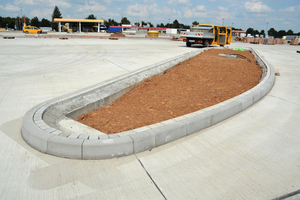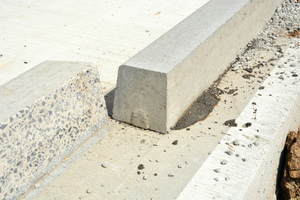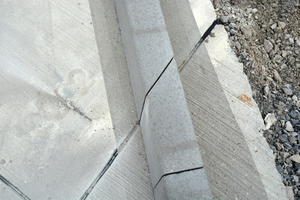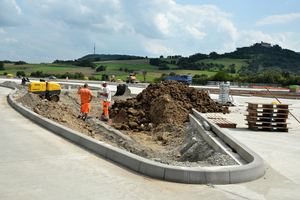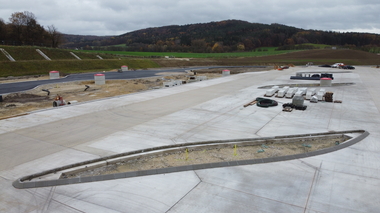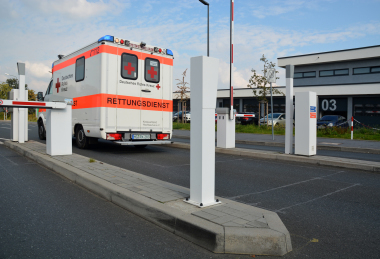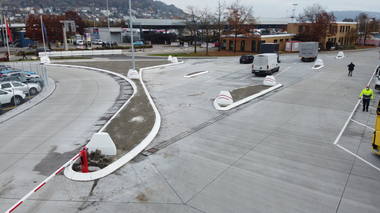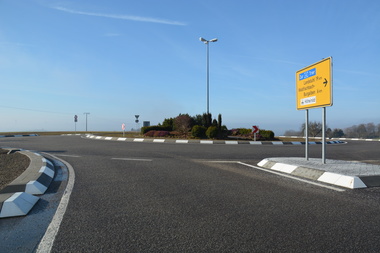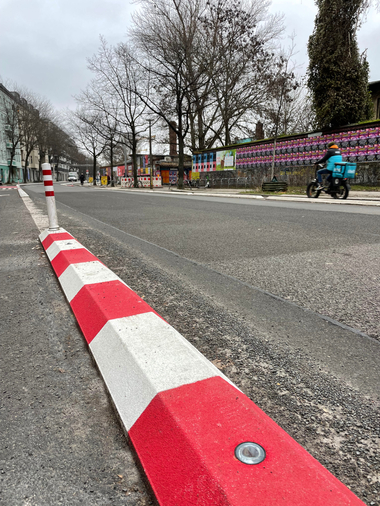10,000 m of adhesive curbstones for safe traffic routing
At present, about 40,000 parking spaces for trucks with overnight accommodation are lacking on German freeways. The German Federal Ministry of Transport is forcing the expansion and new construction of service areas in order to ensure that truck drivers can comply with the compulsory rest periods. In particular, the east-west traffic flows have been growing strongly over the last 25 years. This also affects the A6 freeway between Nuremberg and Heilbronn. For this reason, the service area Hohenlohe near the town of Neuenstein is expanded on both sides.
The service area Hohenlohe built in the ’70’s is situated on A6 between the interchanges Weinsberg and Feuchtwangen/Crailsheim. The expansion from previous 5 to 15 hectares is to ease the parking problem on the A6 freeway to some extent. The number of parking spaces for trucks will be more than tripled by the construction project; in addition, twelve parking spaces for buses, four parking spaces for heavy transport vehicles and six spaces for caravans will be built on each side. The number of parking spaces for cars will be expanded by almost 50 % on the south side and even doubled on the north side. Thus, a total of 205 parking spaces for trucks, 24 for buses and 274 for cars will be available in future.
The construction works are expected to be completed by the end of 2015. The federal government is investing around 18.9 million euros in the new traffic infrastructure.
Curbstone as guidance
Key design elements of the expansion areas are the green islands and the bordering elements that enable a spatial separation of the various types of vehicles, thus improving the quality of stay for all user groups. In this way, directions to the respective parking areas of the gasoline station and service area are given in a clear and target-oriented way. The curbstones play a special role here.
“When constructing new traffic areas, the bordering elements are generally laid at first and not until then the roadways and walkways are paved or blacktopped,” says Dipl.-Ing. André Peritz, construction manager at Leonhard Weiss located in Satteldorf. “This, however, is not possible here, since heavy-duty concrete was used for a large part of the newly paved areas. The slipform pavers used for creating these surfaces, have a fixed paving widths and are therefore not in the position to fill the spaces up to the curbstones properly – especially not when it comes to curves. But owing to the large number of green islands, we have a lot of them here,” Peritz states.
Therefore, the planners were searching for a solution, where the curbstones for the roadways and parking areas are installed subsequently. They decided to use a specific system of curbstone adhesion offered by the concrete block factory Meudt located in Wallmerod for the 10,000 m of curbstones needed.
Durable adhesive bond
All curbstones used up in building, primarily raised curbs of type HB 15/25, were cut to a uniform height of 15 cm by means of a saw. After the concrete surface had been slightly milled, where the curbstones were to be glued later, a two-component adhesive was applied in a thin-bed process to the concrete slabs that were cleaned by water jetting previously and the curbstones were glued to the cut side. This procedure has two advantages: Firstly, the bond on the smooth surface is very strong, because the cement film has been removed. Secondly, any height differences due to production are eliminated, thus calibrating the curbstones for adhesion. Dimensional tolerances are almost impossible, according to the construction manager Peritz.
But how durable is the adhesive bond? “Numerous projects realized in the past demonstrate that a glued curbstone is permanently durable,” Peritz states. This is proven by a test carried out on site by the managers of Meudt before starting the construction works, using the original materials. A forklift fork, which was hit with full force horizontally against the glued curbstone, could not damage the adhesive joint.

